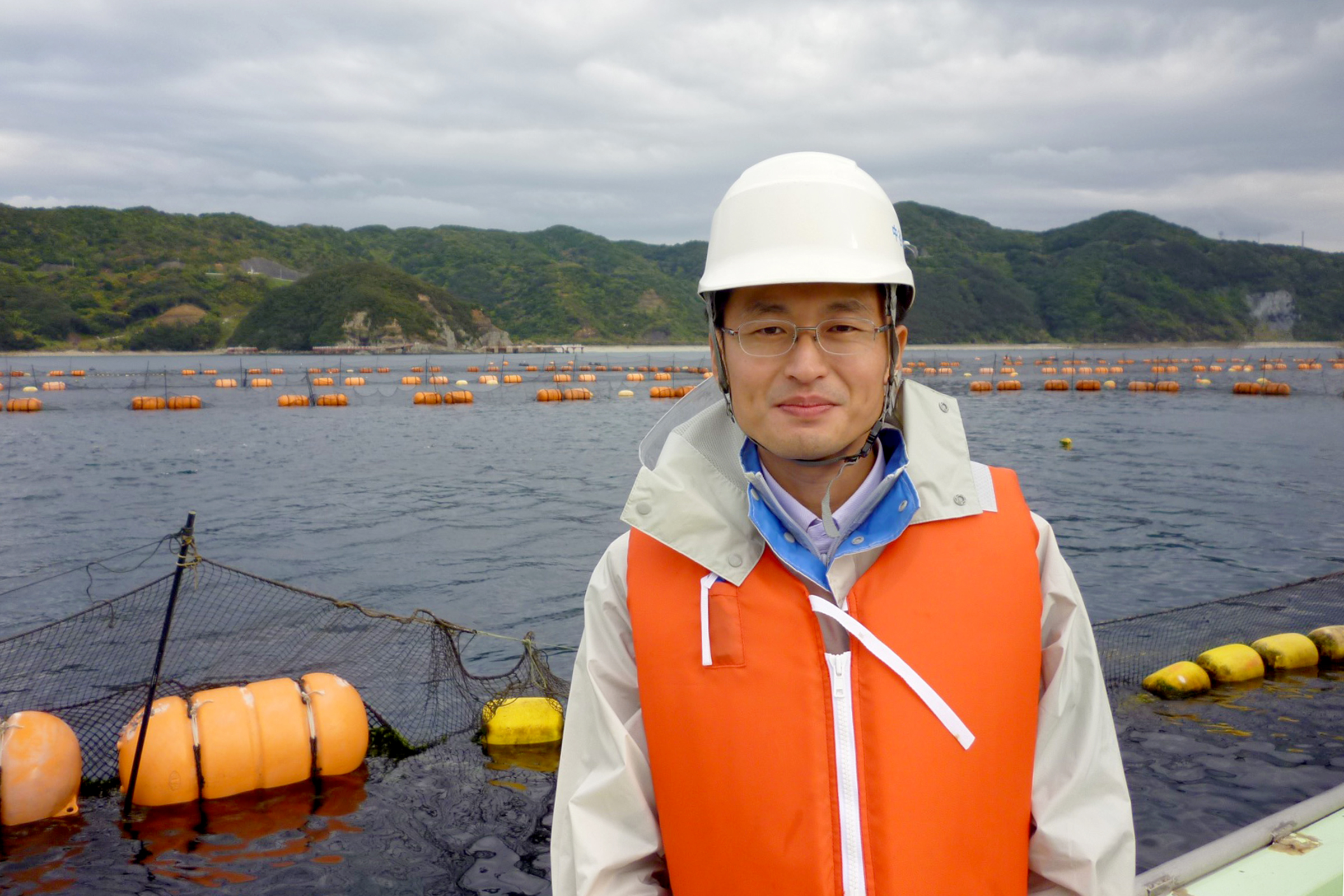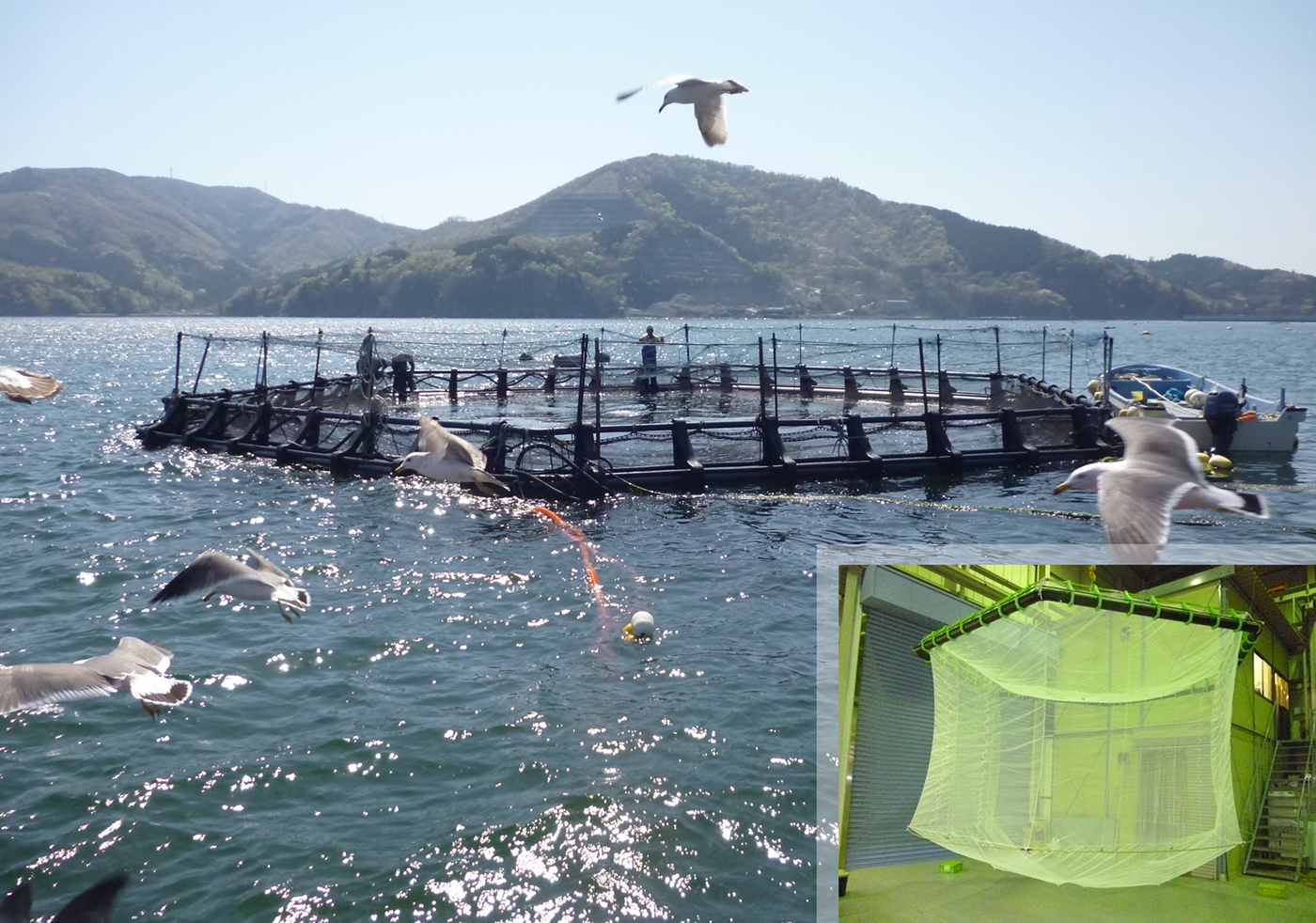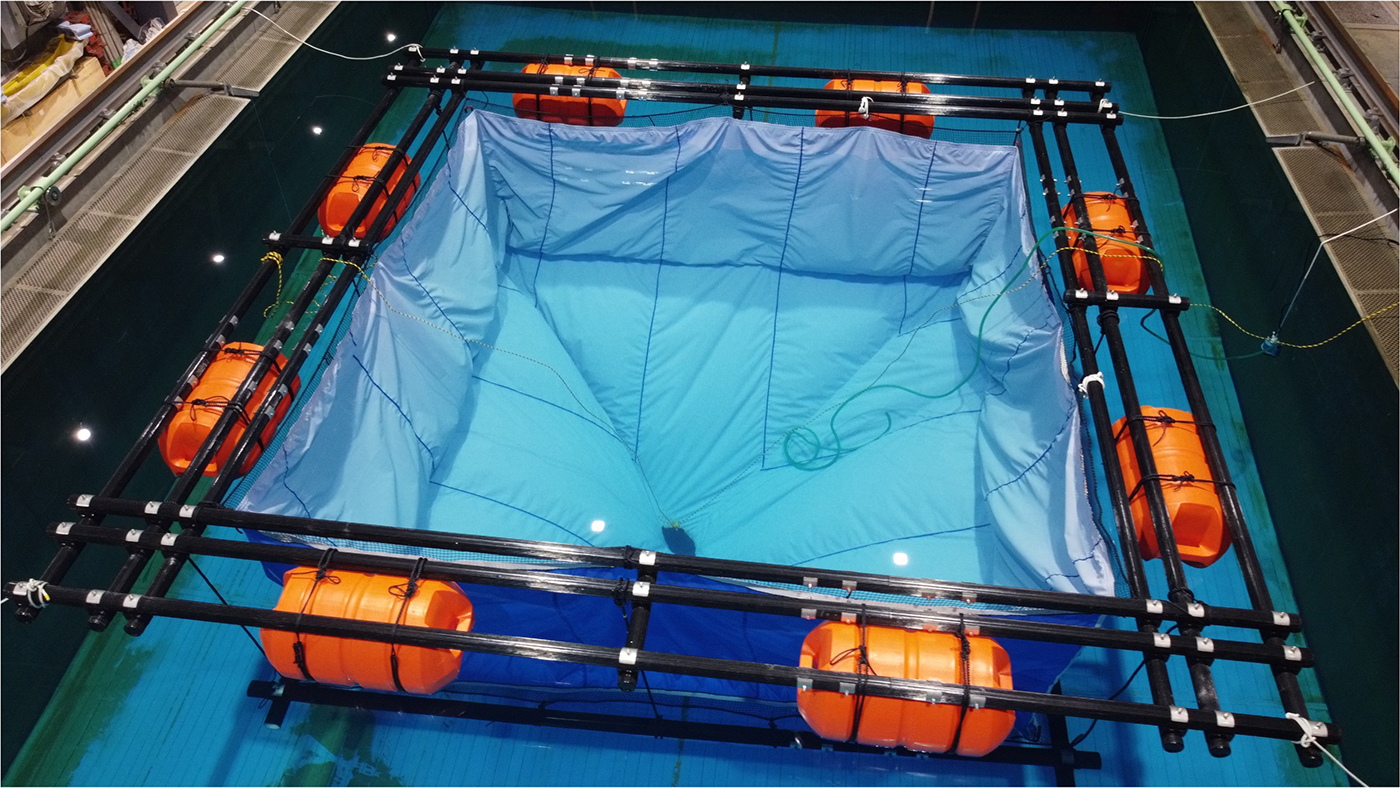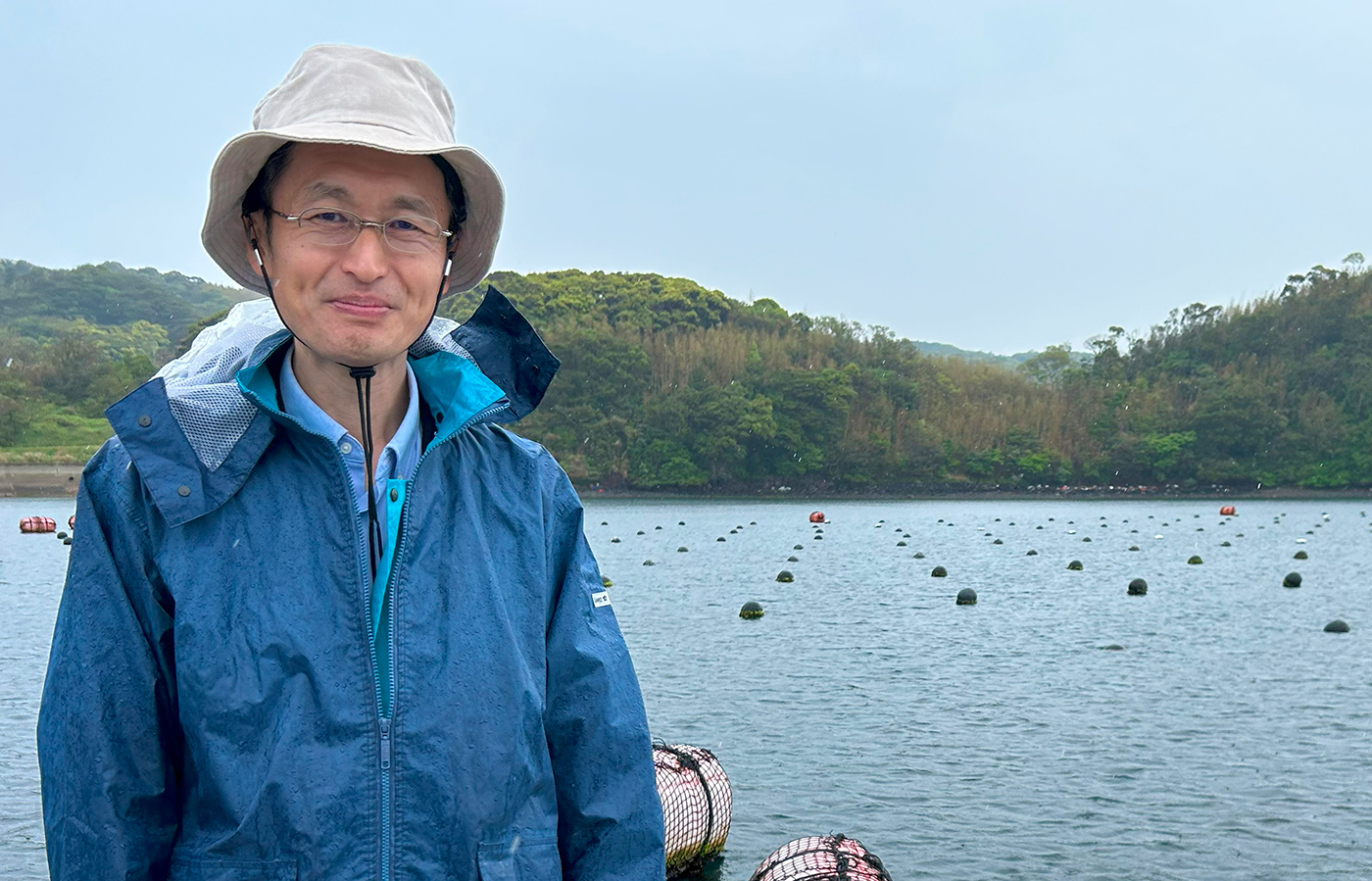Creating New Aquaculture Technologies That Lead Us Into the Future
How Can We Revitalize Marine Industries Amid Advancing Climate Change?

Aquaculture currently accounts for approximately 60% of the total global fish production. This proportion has been increasing since the 1990s, highlighting the growing importance of aquaculture. In response to this, Professor Daisuke Kitazawa of the Institute of Industrial Science, The University of Tokyo, who has long been engaged in ocean-related research such as marine structures and marine energy use, is developing new aquaculture technologies aimed at expanding the areas in Japan where aquaculture is possible. Despite being surrounded by sea, Japan has relatively limited areas suitable for aquaculture, and in recent years, climate change has made conditions even harsher. What technologies are now necessary for aquaculture to continue meeting global demand? We spoke with Kitazawa about the current state and future of aquaculture technologies—and what lies beyond for the ocean and for us.
Expanding Aquaculture Areas and Responding to Global Warming
Aquaculture involves enclosing part of the sea with nets to raise fish and shellfish artificially, but it can’t be done just anywhere. Ideal conditions include moderate waves and currents—not too weak or too strong. In stagnant waters, fish waste accumulates and pollutes the water, while in areas with strong waves or currents, the fish pens may get damaged, and feeding or harvesting becomes difficult.

Conceptual Diagram of Aquaculture Sites and Systems. The “semi-closed circulating marine aquaculture” in coastal areas uses sheet-shaped sea cages. The “closed recirculating land-based aquaculture” uses solid tank-like structures.
Credit: Daisuke Kitazawa Laboratory
As a result, traditional aquaculture has been concentrated in midshore zones—not quite coastal (with little water movement), but not too far offshore (where currents are stronger). Professor Kitazawa has been researching ways to expand aquaculture to both coastal and offshore zones. One of the most notable technologies he has developed—now nearing practical use—is a “submersible pen” system that enables offshore aquaculture.
“As the name suggests, it’s a pen that can rise and sink. By controlling the exchange of air and water inside the frame of the pen, we can raise or lower it. Thanks to this mechanism, we’ve developed large pens that can withstand even typhoons,” he explains.

Submersible Fish Cage. A typical fish cage made of polyethylene frames can be submerged or raised by supplying or exhausting air to a flexible hose inside the polyethylene pipes. In a demonstration experiment conducted in Onagawa, Miyagi Prefecture, coho salmon were farmed at depths of 10 to 20 meters, where the water temperature is lower. This resulted in a longer farming period and successful shipment scheduling.
Credit: Daisuke Kitazawa Laboratory
These submersible pens were developed nearly a decade starting around 2007 and are now being adopted in various locations. However, one challenge remains: how to efficiently feed the fish in offshore pens. Solving this is the next step. Meanwhile, on the opposite end of the spectrum, for coastal aquaculture, Kitazawa is developing pens that use sheet enclosures instead of nets. The motivation for this comes from the impacts of global warming.
“Rising seawater temperatures due to global warming have exceeded optimal levels for fish in some cases. There has also been a noticeable increase in red tides—blooms of phytoplankton. With traditional net pens, fish are directly affected and often die, but by isolating them from the sea with sheet enclosures, we can protect them. This setup requires a system to circulate water in and out of the sheets, which uses energy. Still, it reduces red tide impacts, and by drawing in cooler, deeper water, we can lower the temperature inside the pen to create a more suitable aquaculture environment.”
Submersible pens are also expected to become increasingly important as climate change leads to more intense typhoons. All of Professor Kitazawa’s aquaculture technologies not only aim to expand the range of suitable areas but also address the urgent need for climate resilience in fisheries, making them widely sought after.

Fish cage enclosed with sheets Credit: Daisuke Kitazawa Laboratory
Linking Wind Power with Aquaculture to Revitalize Both
While developing new aquaculture technologies, Kitazawa has also been conducting research on effectively utilizing ocean energy. One example is the development of ships that harness wave energy for propulsion while minimizing rocking. Though the idea of using ocean wave energy as a power source sounds like a dream, it’s still not practical—for instance, it’s difficult to absorb enough energy when docked in calm fishing ports. However, through such research, a more promising and steadily advancing project related to marine energy has emerged: combining offshore wind power facilities with aquaculture.
“As I mentioned earlier, feeding fish in offshore submersible pens remains a challenge. But I believe offshore wind generation facilities (wind turbines) can help solve this. The idea is to place the pens near wind turbines and use the maintenance ships that service the turbines to deliver fish feed at the same time. This would make feeding much easier while the turbines can contribute to not only supplying power but also reducing the energy required for aquaculture.
Kitazawa first conceived of this idea around 2017, but it was not well received at the time. Wind power operators were hesitant, saying “it’s dangerous to place fish pens near turbines,” while aquaculture operators felt “the wind is too strong and the waves too rough near turbines, making operations difficult.” However, the situation changed after climate action became a pressing issue.
“In 2020, then-Prime Minister Suga declared Japan would aim for carbon neutrality by 2050, which accelerated offshore wind power initiatives. Since then, cooperation between wind power operators and fishers has progressed, and people have become more open to my proposal. Offshore wind projects can also contribute to (or revitalize) the local economy, so I hope to realize this concept in a meaningful way.”
If implemented, ensuring safety will be a top priority for Professor Kitazawa and his team. Placing fish pens and turbines close together could significantly alter the surrounding environment, including water currents. They must also determine whether feeding operations can be performed safely and how to efficiently transport feed from the ship to the pens. These challenges will require thorough field testing to find optimal solutions. Considering the likelihood of more severe climate change in the near future, this approach could become a practical reality sooner rather than later.
Revitalizing Japan’s Ocean Industries
When structures are built in the sea, they often give rise to new ecosystems. These ecosystems are usually seen as negative side effects of marine development, but Kitazawa is researching ways to make them beneficial for humans.
“Fish waste typically pollutes the environment, but we’re now exploring ‘integrated multi-trophic aquaculture,’ where that waste becomes food for other organisms and maintains the environment while increasing total biomass. In the case of offshore wind turbines, they too create ecosystems around them, and if these can be integrated with nearby fish farming operations, it could lead to more sustainable and productive systems.”
This approach shows that Kitazawa isn’t looking at aquaculture (farming), energy, and ecosystems as separate fields, but instead sees potential in combining them to create new opportunities. His work is driven by a certain larger goal.
“Japan has historically been a world leader in both shipbuilding and fisheries, and we still have strong capabilities—such as in floating offshore wind power. My ultimate goal is to grow these strengths into globally competitive industries and revitalize Japan’s marine sectors. I also want to help improve Japan’s energy and food self-sufficiency. As a marine researcher, I see that as my mission—and maybe even my dream.”
A Future Where People Live at Sea
Kitazawa’s research progresses through building devices and structures himself, testing them in tanks, then in the ocean, identifying issues, and improving them. He says one of the fascinating aspects of ocean research is how unpredictable the results can be when testing in real-world marine environments. And through these continuous efforts, he hopes to reinvigorate the ocean economy. But what lies even further ahead?
“I believe that someday in the distant future, we may see the creation of ‘floating cities’—places where people live on the sea. These cities wouldn’t be anchored in one spot but would drift freely across the ocean. They would use minimal energy, avoid danger and storms, and allow for self-sufficient living. Imagining that kind of future helps motivate me as I continue to tackle the challenges right in front of me, one step at a time.”

Junbo Zhang, Hiroki Shimizu, Hirotaka Nakashima, Yoichi Mizukami, Takero Yoshida, Lili Liu, Daisuke Kitazawa (2020): Water-tank experiment and static numerical analysis of the mooring system of a controllable depth cage. Aquacultural Engineering 91, 102118.
DOI: 10.1016/j.aquaeng.2020.102118


Comments
No comments yet.
Join by voting
How did you feel about the "Possible Future" depicted in this article? Vote on your expectations!
Please visit the laboratory website if you would like to learn more about this article.
Share